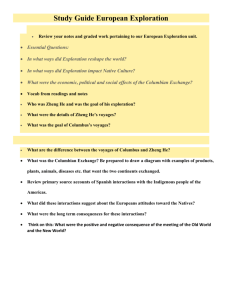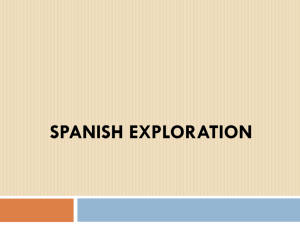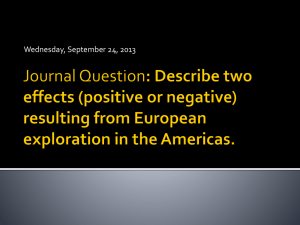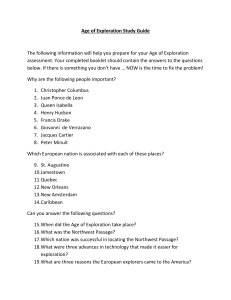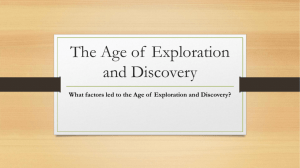Exploration and Expansion Section 1
advertisement
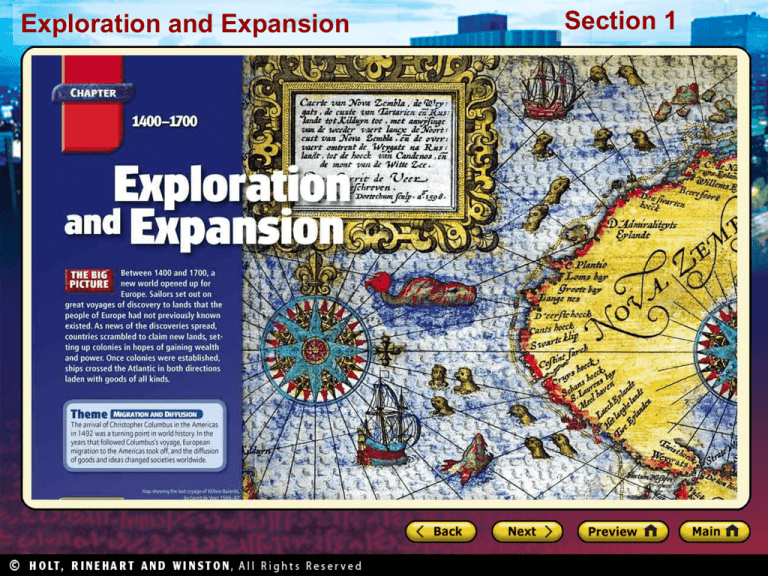
Exploration and Expansion Section 1 Exploration and Expansion Click the icon to play Listen to History audio. Click the icon below to connect to the Interactive Maps. Section 1 Exploration and Expansion Section 1 Exploration and Expansion Section 1 Voyages of Discovery Main Idea During the 1400s and 1500s European explorers—inspired by greed, curiosity, and the desire for glory, and aided by new technologies—sailed to many previously unknown lands. Reading Focus • What were the foundations upon which the Age of Exploration was built? • What discoveries were made by explorers from Portugal and Spain? • What drove explorers from the rest of Europe? Section 1 Exploration and Expansion Foundations of Exploration • Renaissance spirit of discovery and innovation in Europe • Spirit led Europeans to set sail on voyages of discovery • Period is sometimes called the Age of Exploration Drive to Explore • Search for wealth • Europeans desired expensive luxury goods • Flow of goods controlled by Italian merchants • Charged high prices for these rare goods New Routes Faith, Curiosity • Hoped to find new, faster routes to Asia to gain trade foothold • Wealth not only goal • Some set out to find fame, glory • Hoped making great discoveries would bring honor to their names • Other explorers hoped to spread their faith into new lands • Another motive— simple curiosity • Writings like Marco Polo’s very popular in Europe, intrigued many with tales of exotic lands, peoples Exploration and Expansion Section 1 Advances in Technology • Whatever reasons for exploring, Europeans could not have made voyages of discovery without certain key advances in technology • Some advances made in Europe during Renaissance • Others borrowed from people with whom Europeans had contact, especially Chinese, Muslims Navigation • Sailors needed precise means to calculate location • Compass brought to Europe from China, let know sailors know which direction was north at any time • Europeans learned to use astrolabe from Muslims • Navigators could chart location based on sun, stars in relation to horizon Exploration and Expansion Improvements Section 1 Shipbuilding • Just as important as advances in navigation were advances in shipbuilding • Europeans learned to build ships that rode lower in water than earlier ships • Deep-draft ships could withstand heavier waves; also had larger cargo holds Caravels • Caravel, light, fast sailing ship; two features made it highly maneuverable • Steered with rudder at stern, rather than with side oars • Also lateen, triangular, sails; could be turned to catch wind from any direction Popular for Exploratory Voyages • Caravel would also be equipped with weapons, including cannons • Ships could face off against hostile ships at sea • Maneuverability, defensive ability made caravel most popular for exploring Exploration and Expansion Section 1 Summarize How did advances in technology spur exploration? Answer(s): new ships faster and more maneuverable, could better handle sea voyages; navigational instruments allowed for voyages of exploration Exploration and Expansion Section 1 Explorers from Portugal and As a result of their location facing the Atlantic Ocean, Portugal and Spain were well suited to kicking off the Age of Exploration. Spain The Portuguese • Portugal was first country to launch large-scale voyages of exploration • Begun largely due to efforts of Prince Henry, son of King John I of Portugal • Often called Henry the Navigator, not himself explorer • Patron, supporter of those who wished to explore Navigation Court • Early 1400s, Henry established court to which he brought sailors, mapmakers, astronomers, others • Expeditions sent west to islands in Atlantic, south to explore western coast of Africa • Portuguese settled Azores, Madeira Islands, learned more about Africa’s coast Exploration and Expansion Section 1 Exploration Attempts Water Route to India • Prince Henry’s ultimate goal—find water route around Africa to India • Died before goal accomplished; attempts to find such a route not abandoned • 1488, Bartolomeu Dias became first to sail around southern tip of Africa da Gama • 1497, Vasco da Gama set out for India, stopped at several African ports • Learned Muslim merchants actively involved in trade • Journey took more than 10 months, eventually reached Calicut in India Lucrative Trade • da Gama’s trip inspired another expedition to India, led by Pedro Cabral • Sailed west; sighted, claimed land that became known as Brazil • Portugal established trading centers; became rich, powerful European nation Exploration and Expansion Section 1 The Spanish Italian Sailor Columbus’ First Voyage • Spain also eager to seek out new routes to riches of East • 1492, Spanish rulers agreed to pay for voyage by Italian sailor Christopher Columbus • Columbus believed he could sail west from Spain, reach China • Correct in theory, but figures he presented about earth’s size wrong • Also had no idea the Americas lay across Atlantic • Columbus reached island in Caribbean after about two months at sea • Thought he had reached Asian islands known as Indies; called people living there Indians • 1493, returned to Spain with exotic items, including parrots, jewels, gold, plants unknown in Europe • Spanish believed Columbus found new route to Asia, hailed him as hero Exploration and Expansion Section 1 Results of Voyages Columbus—three more voyages to Americas • Still believed he had reached Asia • Error not realized until about 1502 – Explorer Amerigo Vespucci sailed coast of South America, concluded it was not Asia – Mapmakers later named land America in his honor • Knowing they had found new land, Spanish set out to explore it – 1513, Núñez de Balboa led expedition across Isthmus of Panama – After more than three weeks of travel, Balboa became first European to see Pacific Ocean Section 1 Exploration and Expansion Ferdinand Magellan After Balboa’s discovery, the Spanish realized they needed to cross another ocean to reach Asia. West Around World Perilous Voyage • What Spanish did not know was how large ocean might be • Journey long, difficult; some men mutinied, rebelled • Daring adventurer, Ferdinand Magellan decided to sail west around world • Magellan killed in fight with Philippine natives; his men sailed on • 1519, Magellan set out for Spain with five ships, 250 men • 1522, 18 survivors of original fleet arrived back in Spain, first to circumnavigate world Exploration and Expansion Section 1 Explorers and their Routes Chapter 16, section 1, pages 472-473 Exploration and Expansion Section 1 Exploration and Expansion Section 1 Exploration and Expansion Section 1 Analyze What did da Gama, Columbus, and Magellan accomplish? Answer(s): da Gama—reached India via sea; Columbus—landed in the Americas; Magellan— circumnavigated the earth Exploration and Expansion Section 1 Explorers from the Rest of • Spanish and Portuguese did not remain alone in their efforts. • By early 1500s the EnglishEurope and French were exploring northern parts of the Americas. • Dutch later joined in explorations. The English Sir Francis Drake • 1497, first major English voyage of discovery launched • English soon realized they had reached an unknown land, not Asia • John Cabot sailed to Atlantic coast of what is now Canada • Queen sent Sir Francis Drake out • Tried to repeat voyage; fleet vanished, presumably sunk • After stop in what is now California, Drake sailed north to seek route around North America The weather was too cold, and he ended up heading west around the world to get back to England. He became the second man to circumnavigate the globe. Exploration and Expansion Section 1 Henry Hudson • England wanted to find shorter route to Asia than Magellan found • • • • • Sent Dutch-born sailor Henry Hudson 1607, Hudson set out to north Hoped to find Northeast Passage around Europe Found nothing but ice, returned to England Later made two more voyages for English, one for Dutch The French • Also wanted to find passage to Asia • Sent explorers to look for Northwest Passage • 1534, Jacques Cartier sailed past Newfoundland into St. Lawrence River, claimed land as province of New France, now Canada The Dutch • By 1600s Netherlands powerful trading nation, hoped to find new products, trading partners • 1609, Henry Hudson set out to find Northwest Passage • Did not find passage, but did explore river now named for him Exploration and Expansion Section 1 Find the Main Idea What did English, French, and Dutch explorers hope to find? Answer(s): a shorter route to Asia Exploration and Expansion Section 1 Exploration and Expansion Section 1 Exploration and Expansion Section 1 Exploration and Expansion • • • • • Geography Climate Christopher Columbus Spanish Explorers English Explorers Section 1
